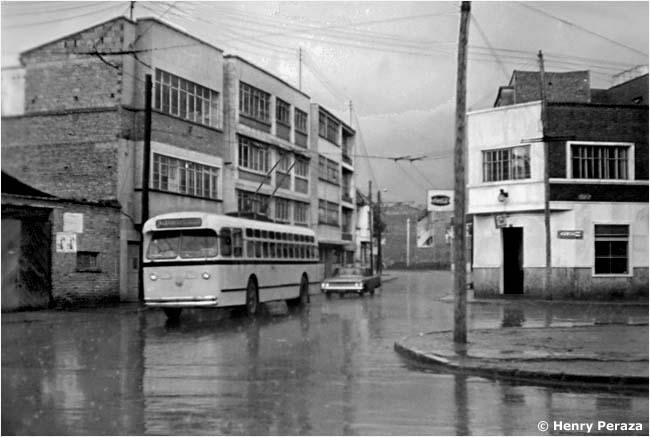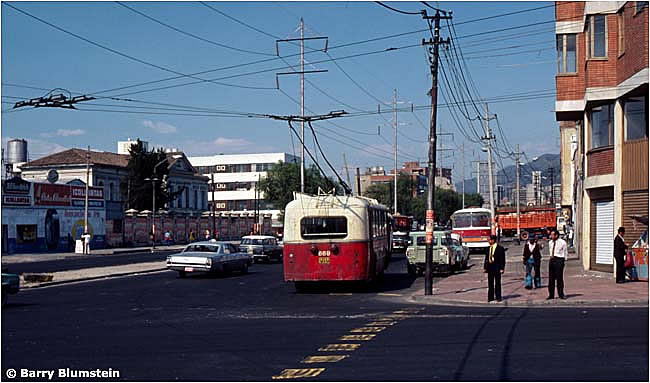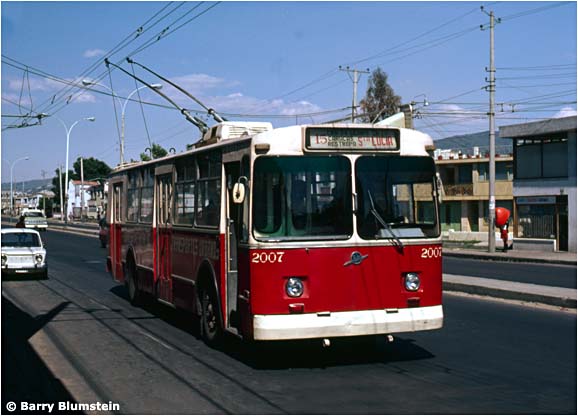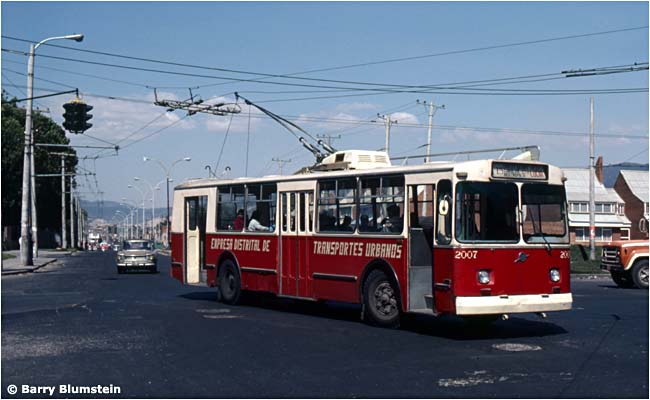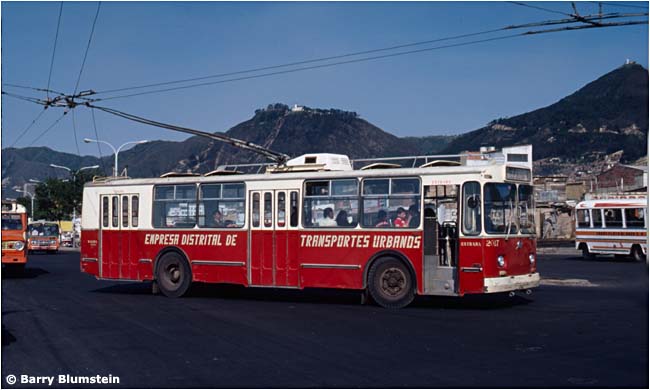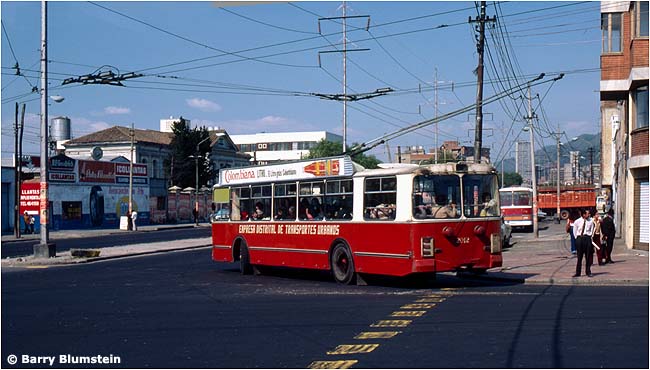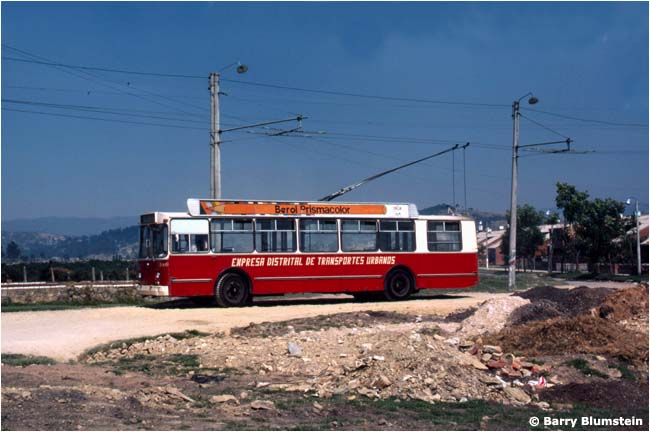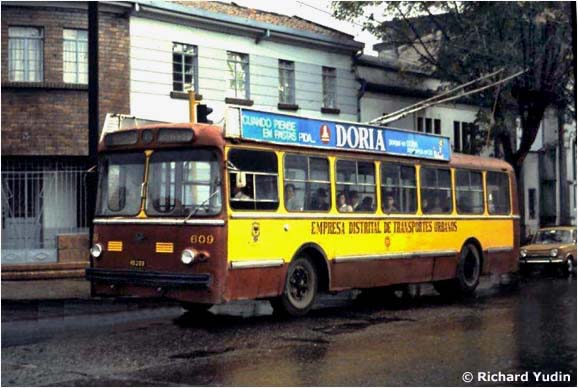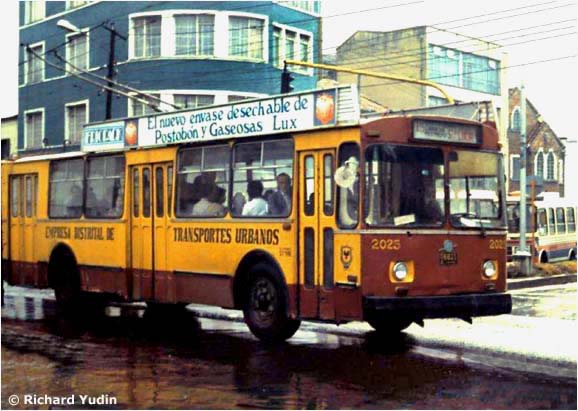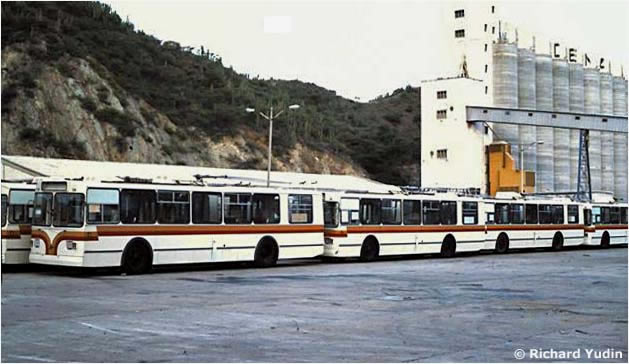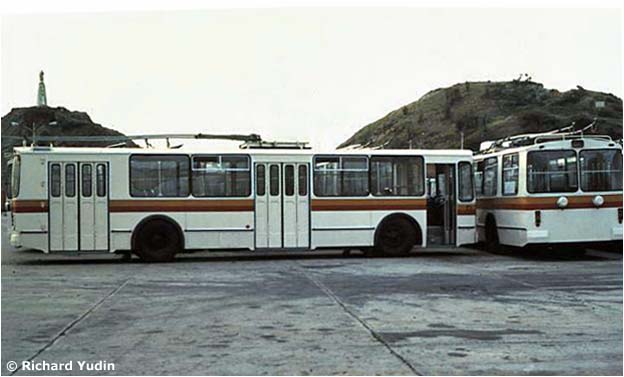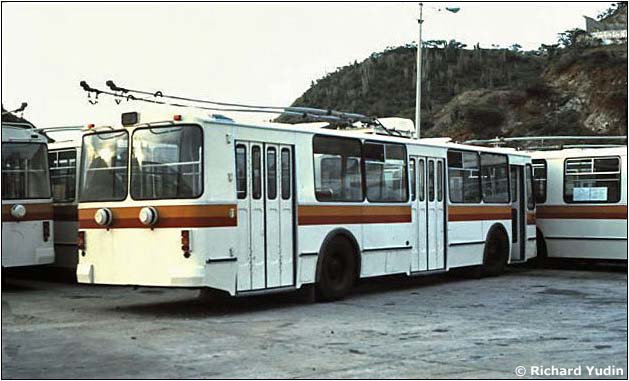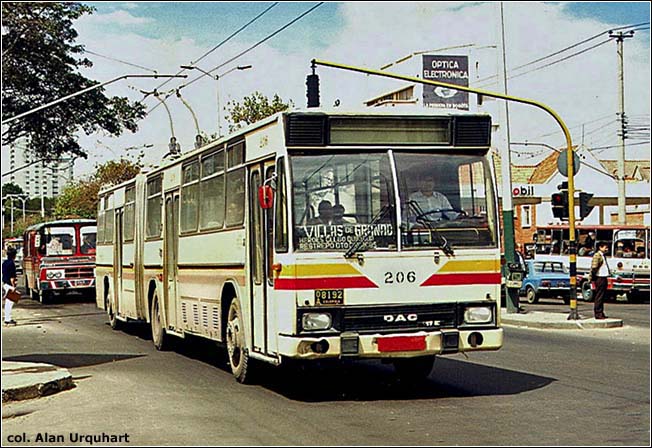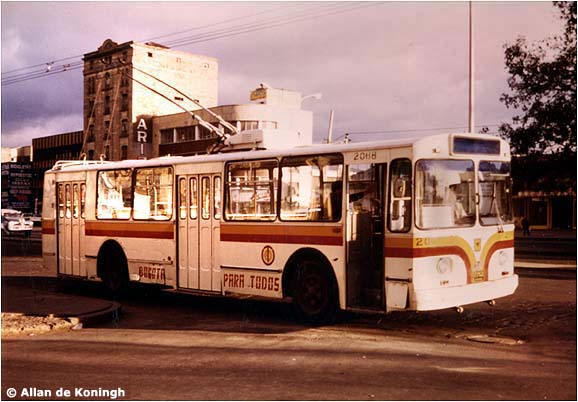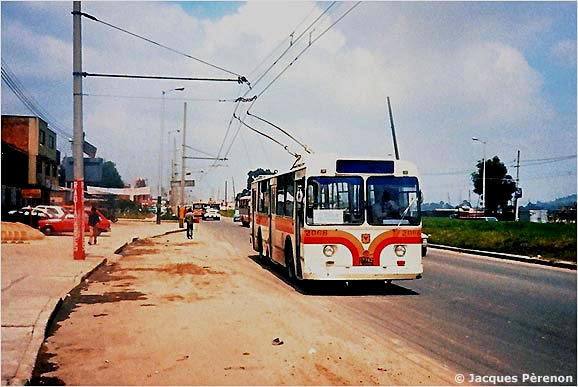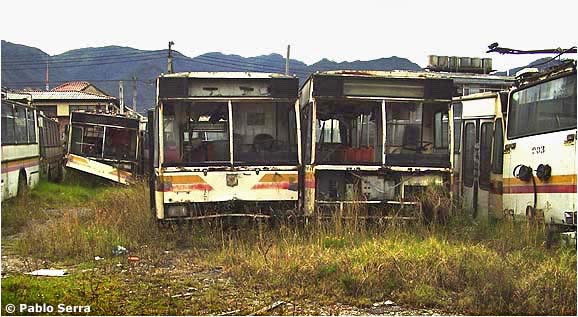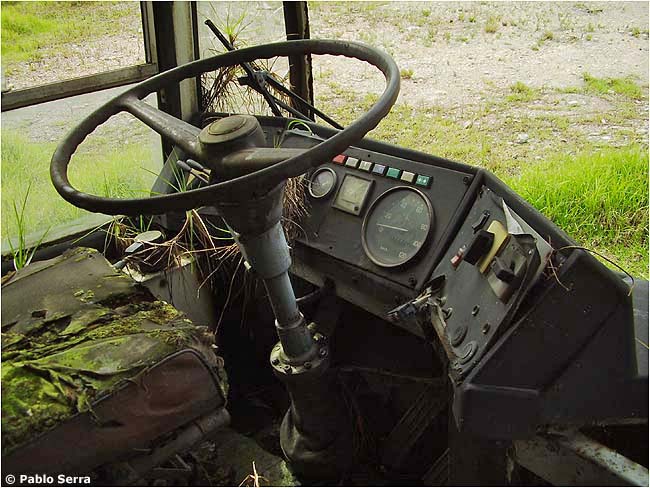B O G O T Á
COLOMBIA
BY
Allen Morrison
This page is dedicated to the memory of my friend
Claudio Bellon ("claudiotren" on the Internet),
a Bogotá native who was researching
the transport history of his hometown
when he lost his battle with cancer,
on 5 October 2006.
Adiós, Claudio.
South America's fifth-largest city (after São Paulo, Buenos Aires, Rio de Janeiro and Lima) sprawls across a plain at altitude 2,610 m (8,563 ft). The Andes rise to 3,300 m (10,827 ft) on the city's east side [see map]. Bogotá is the continent's third-highest capital (after La Paz and Quito). Its population was about 100,000 in 1900, was about 700,000 in 1950, and is about seven million today. The first railway was a horsecar line that began carrying passengers in 1884. A short steam railroad opened in 1889, but because of the country's rugged terrain Bogotá did not have rail access to a navigable river until 1909, or a direct rail connection with a seaport until 1961. Both the horsecars and the first electric trams, built in 1907 [see The Tramways of Bogotá], were disassembled and carried up the mountain on the backs of mules. Most of the city's horse trams and electric trams were built by J. G. Brill in Philadelphia, Pennsylvania, USA. The city's first 20 trolleybuses were built in 1947 by a Brill affiliate, Canadian Car & Foundry, in Fort William, Ontario, Canada. They were numbered 1-20 and later renumbered 1001-1020. The tramway operator, Tranvía Municipal de Bogotá (TMB), opened the first trolleybus line, between the tram depot on Calle 26 and Ciudad Universitaria, on 12 April 1948 [see map]. The route was soon extended down Av. Caracas to Los Mártires and La Hortúa. The photograph below of TMB 17, one of the CCF-Brill model T44 trolleybuses of 1947, was taken in July 1951. The destination sign reads "LA HORTUA – CIUDAD UNIVERSITARIA" [Edward C. Piercy]:
TMB ran its last tram on 30 June 1951. Between 1956 and 1959 it purchased 70 used trolleybuses from three transport systems in the United States: 10 Pullman trolleybuses from Greenville, South Carolina, in 1956; 10 Brill trolleybuses from Baltimore, Maryland, in 1957; and 50 trolleybuses – 20 built by Brill and 30 by Marmon-Herrington – from Kansas City, Missouri, in 1959. In the latter year Bogotá's bus services, both gasoline and electric, were transferred to the new Empresa Distrital de Transportes Urbanos. EDTU built a new depot for its 90 trolleybuses on Av. Chile at Carrera 24 and extended its line on Av. Caracas north to the districts called 12 de Octubre and Minuto de Dios [see map]. It also numbered its trolleybus routes and renumbered its trolleybuses. (Route numbers are not shown on the map because not all numbers are known.) In the early 1960s Bogotá resident Henry Peraza took the photograph below of the interior of trolleybus 1020, one of the original CCF-Brills of 1947. It was originally numbered 20 [Henry Peraza]:
At about the same time, Sr. Peraza captured this rare view of one of the Marmon-Herrington trolleybuses from Kansas City. Number 56 is proceeding southwest on Carrera 20 near the city center. It is about to turn left onto Calle 22 [see map] [Henry Peraza]:
Not many photographs of the city's early trolleybuses could be found. The 1962 page of the Historia del Transporte Público en Bogotá shows pictures of trolleybuses 19 and 26. The latter is one of the 10 trolleybuses that Bogotá purchased from Baltimore in 1957, which Brill had built for that city in 1948. Destination sign says "8 / 12 DE OCTUBRE". A Buses de Colombia page presents 23 photographs of Bogotá trolleybuses in scrapyards in the 1990s. The third picture on the Latin America page of the St. Petersburg Tram Collection of Russia shows the model that it produced of the Pullman trolleybus that Bogotá acquired from Greenville. The page also shows models of Bogotá's ZiU and Brill trolleybuses. The Colombian government's Estadística del Distrito for 1965 reported 34 trolleybuses in service on three routes: #8 / 12 de Octubre – Quiroga; #9 / Centro Nariño – Quiroga; and #12 / Minuto de Dios – San Cristóbal [see map]. The 1966 Estadística reported only 27 trolleybuses in operation. The three routes were the same in 1966, except that the southern terminus of #8 had moved from Quiroga to San Isidro. Two-thirds of the trolleybus fleet was out of service. In 1967 EDTU purchased 100 new type ZiU-5 trolleybuses from Uritsky in the U.S.S.R., which it numbered 600 to 699. New trolleybus services were established on Carreras 14, 17 and 24 and nine branches of these lines spread north, south and west [see map]. Each branch was extended as the city grew. Australian transport enthusiast Barry Blumstein visited Bogotá in February 1978 and took the following nine pictures [scanned from slides]. The destination board of number 640, below, reads "12 DE OCTUBRE – CARRERA 17 – CALLE 72" [see map]. The photographer was facing north at the terminus in San Isidro [Barry Blumstein]: |
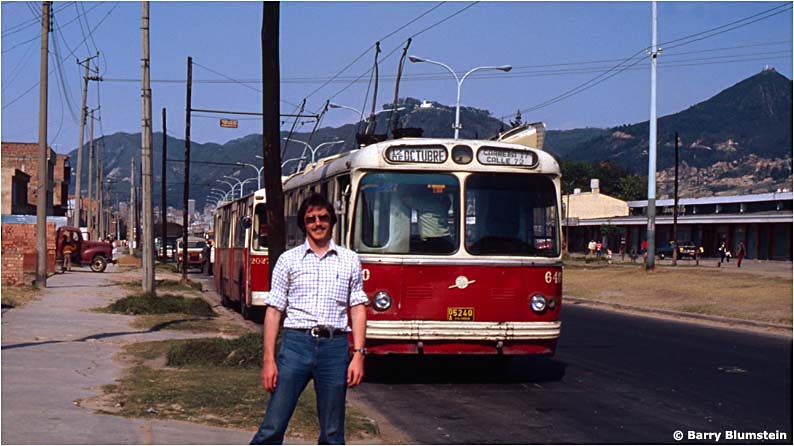 |
Here is another picture of a Uritsky ZiU-5. Trolleybus 609 is signed for route 15 "QUIROGA – CARRERA 24 – CAMPIN – SEARS" and has just turned south from Calle 39 onto Carrera 19 [see map] [Barry Blumstein]:
EDTU 669, in the picture below, is traveling north on Av. Caracas, at its junction with Calle 1, not far south of the city center [see map] [Barry Blumstein]:
In 1974, according to Soviet records, EDTU purchased at least 147 more trolleybuses from Uritsky, this time its model ZiU-9. This photograph shows Uritsky ZiU-5 trolleybus 695 passing a ZiU-9 numbered 2007. Number 695 is signed "SAN ISIDRO – CARRERA 17 – CALLE 72" [Barry Blumstein]:
In this photograph 2007 is signed for route 15 "CRR 24 SEARS CR 19 – CARACAS – RESTREPO – STA LUCIA" (yes, there are two different abbreviations of Carrera) [see map] [Barry Blumstein]:
Another picture of the vehicle above, taken a few seconds later. Santa Lucia is in the southwest corner of the city [see map] [Barry Blumstein]:
Here is ZiU-9 trolleybus 2017 signed "SAN CRISTOBAL" (other words in the destination box are illegible). The funicular railway that climbs to the church atop Monserrate hill, altitude 3,190 m (10,466 ft) [see map], is visible above the trolley poles [Barry Blumstein]:
In this photograph EDTU 2012 is turning north from Calle 1 onto Av. Caracas [see map]. This is the area called La Hortúa, the same place shown in the third color view above [Barry Blumstein]:
ZiU-9 trolleybus 2006 on a terminal loop somewhere in Bogotá in February 1978. The author does not have information about the turning loops at the ends of the trolleybus lines. On some routes the trolleybus may have gone around the block [Barry Blumstein]:
A visitor in 1984 found a very different livery on some of the Russian vehicles. Here is ZiU-5 number 609 – also seen in the third photograph above. It is signed for route 15 "QUIROGA" on the south side of town. The photograph was taken on Carrera 19 at the corner of Calle 32 [see map] [Richard Yudin]:
The 1984 view below shows a ZiU-9 signed for route 15 "SANTA LUCIA" [see map]. Like trolleybus 609 above, number 2029 is also traveling south on Carrera 19, near Calle 30 [Richard Yudin]:
The next ZiU-9 is also signed 15 "SANTA LUCIA" (which was a shortened version of route 13 "SAN CARLOS") [see map]. This photograph was taken on that same rainy day in 1984, on Carrera 19 at Calle 30 [Richard Yudin]:
In 1985 Mr. Yudin photographed a large group of new ZiU-9 trolleybuses on the dock in Santa Marta, a port on Colombia's Caribbean coast. Here was yet another livery of white with red and yellow stripes. These vehicles no doubt represented the balance of the 147 trolleybuses ordered in 1974. Here are three of his photographs [Richard Yudin]:
Note that these vehicles do not yet have fleet numbers [Richard Yudin]:
This trolleybus will keep the others from escaping [Richard Yudin]:
The new Soviet vehicles shown above left Santa Marta shortly after these pictures were taken. But it is not known how many, if any, of them ever ran in Bogotá. Previously, in 1982, EDTU had purchased 98 type 112-E trolleybuses from DAC in Romania, which it numbered 001-098. In the photograph below, taken by Bogotá resident Gustavo Arias in 1985, Uritsky 2042 precedes two of the DACs, the first one numbered 010. The destination sign of 2042 reads "VILLAS DE GRANADA". Most of the words in 010's box are illegible, but one of them is "KENNEDY" [see map] [Gustavo Arias]:
DAC 003 has lost its roll sign so displays a board, which reads "CR 24 SEARS – RESTREPO – QUIROGA" [see map]. The location is probably Carrera 24 in the Campin area, where the north- and south-bound routes diverged for several blocks [Gustavo Arias]:
In 1985 Bogotá acquired eight 3-axle articulated trolleybuses from DAC, model 117-E. EDTU numbered them 201-208 and ran them briefly on several lines. A dispute about the salaries for the drivers of articulated vehicles was never resolved. Here is the only known picture of a 3-axle trolleybus carrying passengers in Bogotá. Number 206 was photographed in 1988 on the long Villas de Granada line [see map] [col. Alan Urquhart]:
Dutch transport enthusiast Allan de Koningh photographed Uritsky 2068 in front of La Sabana railway station on Calle 13, on the Kennedy line, in October 1987 [see map]. The inscription translates "BOGOTA FOR EVERYBODY" [Allan de Koningh]:
French visitor Jacques Pèrenon photographed the same trolleybus, number 2068, on Av. 81 near Villas de Granada [see map] in February 1988 [Jacques Pèrenon]:
In the previous four decades, since 1947, Bogotá seems to have purchased – if not operated – at least 443 trolleybuses: 20 new from CCF-Brill in Canada, 70 second-hand from U.S. systems, 247 new from Uritsky in the U.S.S.R., and 106 from DAC in Romania. But maintenance was uneven and a 1990 newspaper article described the system as "in a permanent state of ruin" [see BIBLIOGRAPHY below]. A 1991 article said that only 80 of 250 trolleybuses were in service, and that of 195 km of wire only 125 were in use. Russian engineers were summoned to Colombia to try to save the system. The engineers reported that most of the vehicles could be recuperated and a new company, Trolebús Bogotá S.A., was formed to run them. But it was no use. The last trolleybus in Bogotá operated on Thursday night 15 August 1991 and the Empresa Distrital de Transportes Urbanos was liquidated at the end of that year. The trolleybus company in Valparaíso, Chile, expressed interest in buying some of the vehicles, and the trolleybus line under construction in nearby Quito, Ecuador, considered them as well. But nothing happened. The surviving trolleybuses were gathered at the depot on Av. Chile and in a field near Parque Jaime Duque at Briceño, 40 km north of the capital. Many of the vehicles had never carried passengers. A newspaper editorial lamented "the poor man's funeral" that was accorded a vital chapter in the city's transport history. Bogotá inaugurated the first section of its reserved-lane diesel bus system called Transmilenio on 1 January 2001. In 2007 a satellite view on Google Earth revealed that 42 trolleybuses were still sitting in the yard on Av. Chile [see map] – sixteen years after the system had closed! Chilean trolleybus enthusiast Pablo Serra went to Bogotá in October 2007 and took the following four photographs (among others):
All the vehicles in the yard seemed to be 2-axle Romanian DACs. In the photograph below, the trolleybus far left is numbered 098, but no vehicle with a number that high was ever seen in operation [Pablo Serra]:
The interior of a DAC [Pablo Serra]:
The surreal image below would probably have delighted Salvador Dalí or René Magritte – especially since the scene is real [Pablo Serra]:
Amazingly, Bogotá was also visited in October 2007 by an Englishman, Peter Haseldine, who is news editor of Trolleybus Magazine. Mr. Haseldine traveled to Briceño and photographed the other group of survivors, mostly Russians, which also had not been disturbed for 16 years. A fence prevented close views [Peter Haseldine]:
In this second picture, trolleybus 2147 on the left has the highest number seen on the Bogotá fleet. The vehicle next to it, with the high rear window, is a DAC – perhaps one of the articulated models. The view is east, toward the Andes [Peter Haseldine]:
In January 2011 a local enthusiast, Juan Pablo Cutiva, photographed DAC articulated trolleybus 209 at the trolleybus yards on Calle 72 at Carrera 24 [see map]. It had always been believed that the eight articulated trolleybuses were numbered 201-208... [Juan Pablo Cutiva]:
The other side of articulated trolleybus 209. It was difficult to photograph in the tight space. These are among the very few known pictures of articulated trolleybuses in Bogotá [Juan Pablo Cutiva]:
Number 209 and thirty other trolleybuses were still sitting in that yard in July 2013, twenty-two years after the system closed.
Bogotá. Registro Municipal, 30/9/1941, p. 546. U.S. transport consultants recommend that Bogotá replace its trams with buses de gasolina y de trolley. The first trolleybuses will run on Av. Caracas. Bogotá. Registro Municipal, 14/11/1947, pp. 560-561. The 20 new trolleybuses will start running on Calle 26 in early 1948. Bogotá. Registro Municipal, 17/3/1948, pp. 84-85. Description of the new trolleybus line on Calle 26. Plans for future trolleybus lines. "17 Buses de Trolley Servirán en la Línea Av. Chile - San Francisco" in El Tiempo (Bogotá), 16/6/1948, p. 3. The 17 trolleybuses that will open the new line are the same as the three that have been running for several weeks on Calle 26. "Mañana se inaugurará la línea de trolley hasta la plaza de Los Mártires" in El Tiempo (Bogotá), 5/10/1948, p. 3. Inauguration of the city's second trolleybus line. Bogotá. Departamento de Estadística e Investigación Social. Anuario Municipal de Estadística, 1948. Data for the Tranvía Municipal, pp. 164-167. This government survey divides data into two groups – before and after 9/4/1948, the day when rioters destroyed government buildings and 28 trams (but not the 20 trolleybuses). The chart on p. 166 indicates that three trolleybuses were serving the Ciudad Universitaria line from 12/4/1948. Bogotá. Departamento de Estadística e Investigación Social. Estadística de la Ciudad de Bogotá. Tranvías y Buses Municipales. Trolleybus stats: 1949 edition, p. 187; 1950 edition, p. 176; 1951 edition, p. 182. Bogotá. Departamento de Estadística e Investigación Social. Anuario Municipal de Estadística. Data for the Empresa Distrital de Transportes Urbanos: 1965 edition, pp. 194-196; 1966 edition, pp. 194-196. Vehicles in service, kilometers traveled, passengers carried, fare receipts, etc., for each of the city's trolleybus lines. "Acuerdo para liquidar la empresa de buses" in El Tiempo (Bogotá), 7/12/1990. Plans to liquidate the EDTU, which is in a "permanente estado de ruina". Only 27% of its vehicles are in service. A new company may be formed to operate the trolleybuses. "Liquidada la Empresa Distrital de Buses" in El Tiempo (Bogotá), 26/2/1991. Liquidation process has begun, but the trolleybuses may be saved. EDTU owns 250 trolleybuses, but only 80 are in service. There is 195 km of wire, but only 125 km is used. Russian engineers are in Bogotá to study the possibility of restoring trolleybus service. "La Empresa de Buses no se debe vender por chatarra" in El Tiempo (Bogotá), 23/5/1991. The EDTU should not be sold for scrap. 95% of the trolleybus fleet can be recuperated and a new company called Trolebús Bogotá S.A. can run them. "Interinidad en seis empresas del Distrito" in El Tiempo (Bogotá), 3/9/1991. A Chilean company is interested in buying EDTU's trolleybuses . . . "Año nuevo, ¿empresa nueva?" in El Tiempo (Bogotá), 24/12/1991. EDTU will be dissolved at year's end. Trolleybuses have not run since last 15 August. This is the only statement of EDTU's closing date that the author could find. No mention of the event was found in any edition of El Tiempo during August 1991! "Trolebus [sic] recibió entierro de pobre" (Trolleybuses got a poor man's funeral) in El Tiempo (Bogotá), 23/5/1992. The new trolleybus company died before it was born. 250 trolleybuses rot in an open field. "Los 'trolleys'; nostalgia eléctrica en subasta" in El Espectador (Bogotá), 26/5/1996, p. 1-F. Plan to refurbish the rotting trolleybuses, install gasoline motors and run them again. Two large photographs. Alan Murray. World Trolleybus Encyclopaedia. Reading (U.K.), 2000. Brief description and data for the Bogotá trolleybus system, pp. 48 and 81. Data for its CCF-Brill trolleybuses, p. 96; DAC trolleybuses, p. 111; Uritsky trolleybuses, pp. 113-114. Buses de Colombia. 23 photographs of scrapped trolleybuses in the Trolebús section about half-way down the page.
See also and If you have comments, criticism or suggestions, This site was placed online on Copyright © 2007-2107 Allen Morrison |


